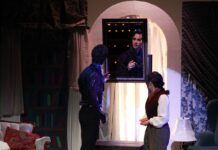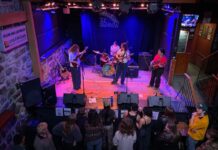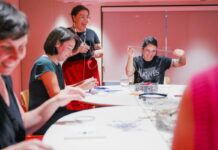
For students, Sept. 5 marked the day before start the of classes. Others could enjoy a visit and lecture from a Nobel laureate.
Peter Grünberg is a former Carleton postdoctoral fellow from 1969-1972 and had visited the university the night prior to accept an honorary doctorate for his lifetime achievements, and for his time spent at Carleton. Grünberg captivated a niche audience of 120 attendees with information on the link between mathematics and harmony found within music.
The lecture began with introductions by associate professor of performance studies in music, James Wright.
“Why do we have a feeling of warmth when we hear certain types of music?” he asked. “And why do other kinds of music give rise to feelings of aggressiveness or tension?”
Those feelings are based on a natural reaction towards consonance and dissonance, he said. He also discussed details on inflection found within speech. Consonance is the combination of notes received positively by the majority listeners while dissonance is combination of notes received negatively by majority listeners.
Wright said that both consonance and dissonance are caused through the positive or negative reaction based on a combination of notes. This combination includes measurement of frequency, quality and the length of intervals between notes, he said.
He dove deeper in his analysis, discussing the mathematics behind sound frequencies. Specifically, note frequencies are processed with Fourier analysis, a system devised by mathematician Jean Baptiste Fourier.
Grünberg then treated audience members to the anticipated performance. Accompanied by soprano Keiko Hibi, the pair provided examples of the theory through song. Demonstrating dissonance by strumming several notes of “My Bonnie Lass” incorrectly, Grünberg made it clear to the audience that there is an unspoken, universal language in music. Grünberg said that although “My Bonnie Lass” is a familiar song to most, it has repercussions when played incorrectly.
Event coordinator and science faculty administrator Heather Martell said Grünberg specifically requested a second night for the performance. The purpose of a second night was to provide an auditory example that would help in understanding the relationship between physics and harmony.
Having a lifelong passion for music, Grünberg began to play the classical guitar at a young age, he said in an interview with the Charlatan. He reminisced on his time spent in Boy Scouts, where he was often asked to accompany the group’s singing with his guitar.
That was when when Grünberg began contemplating “the recipe to find the right chord.” From then on, the search for the perfect recipe became a lifelong hobby, only to develop further with his study of physics.
Grünberg completed the evening as the audience joined in on a rendition of “My Bonnie Lass.”





